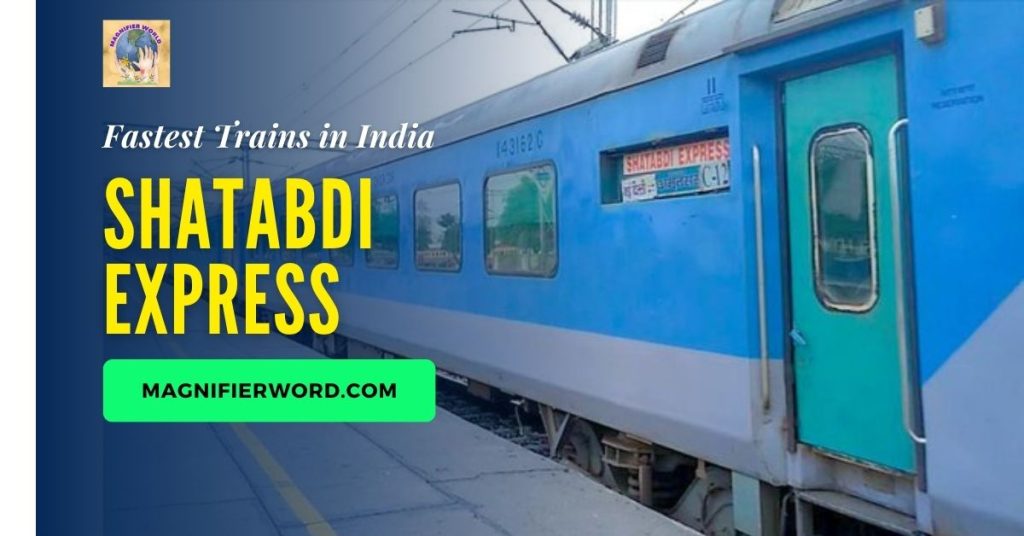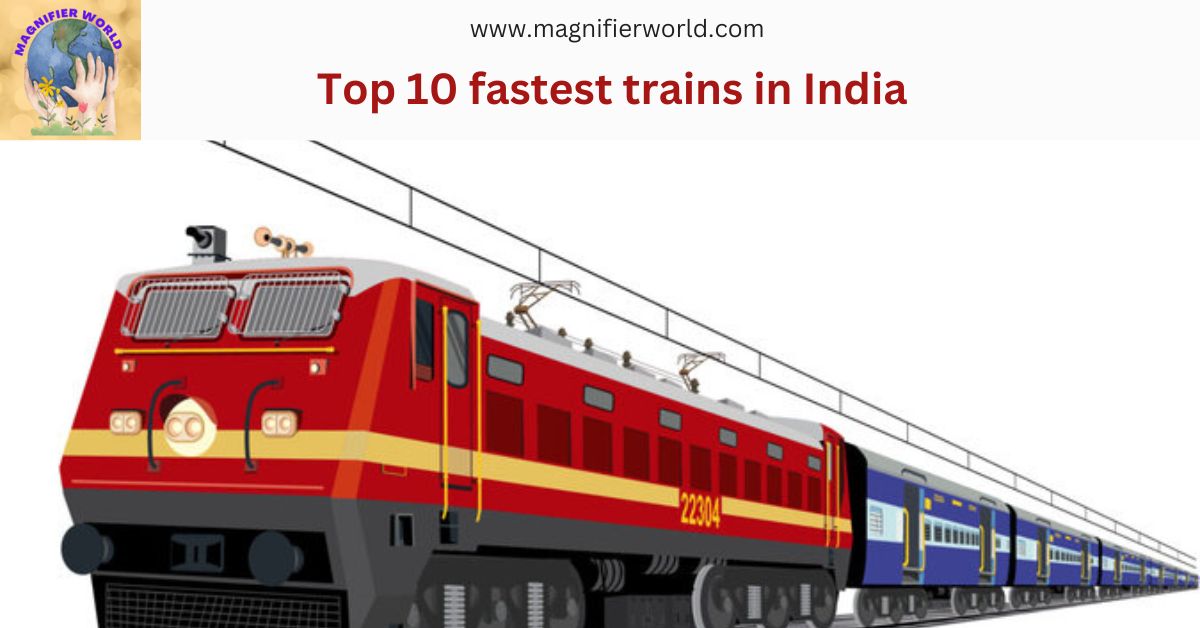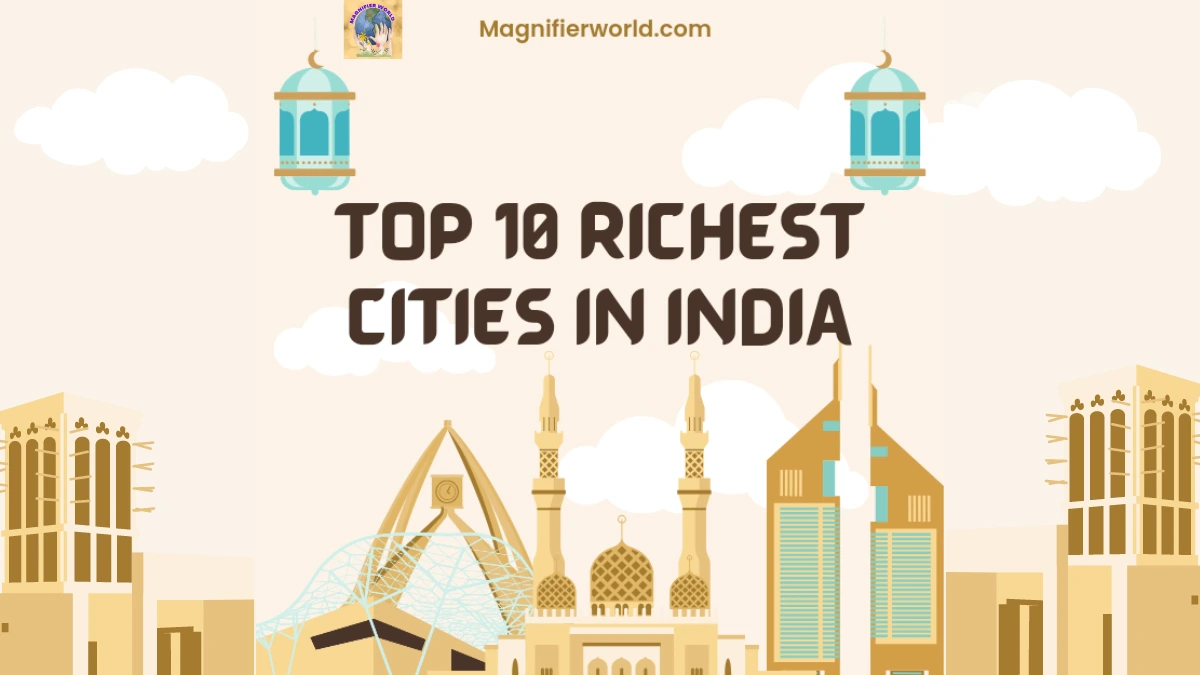Top 10 fastest trains in India, India’s railway network, one of the largest in the world, has evolved over the years, not just in terms of connectivity but also in speed. The introduction of high-speed trains has transformed the passenger experience, reducing travel time and enhancing efficiency.
Let’s embark on a journey through the tracks to discover the top 10 fastest trains in India, where speed meets comfort and innovation.
1. Gatimaan Express:

Top 10 fastest trains in India -Topping the list is the Gatimaan Express, known for its swift journey between Delhi and Agra. With a top speed of 160 km/h, it not only connects the two iconic cities but also sets the pace for high-speed rail travel in India.
2. Vande Bharat Express:

Popularly known as the Train 18, the Vande Bharat Express is a symbol of modernity and speed. Top 10 fastest trains in India with a top speed of 180 km/h, it operates between New Delhi and Varanasi, offering a premium travel experience with its state-of-the-art amenities.
3. Bhopal Shatabdi Express:

The Bhopal Shatabdi Express is a high-speed train that connects New Delhi and Bhopal, reaching speeds of up to 150 km/h. Known for its punctuality and efficiency, the Top 10 fastest trains in India provide a swift and comfortable journey for passengers.
4. New Delhi-Mumbai Rajdhani Express:

The Rajdhani Express is synonymous with speed and luxury. The New Delhi-Mumbai route boasts one of the fastest Rajdhani Express trains, touching speeds of 140 km/h, ensuring a rapid connection between the political capital and the financial capital of India.
5. Sealdah-New Delhi Duronto Express:

The Duronto Express is a non-stop train that connects Sealdah and New Delhi at speeds of up to 130 km/h. With its streamlined services and time-efficient travel, it has become the Top 10 fastest trains in India.
6. Howrah-New Delhi Rajdhani Express:

The Howrah-New Delhi Rajdhani Express is another feather in the cap of Indian Railways. Reaching speeds of 130 km/h, it links the bustling city of Kolkata with the national capital, offering a swift and comfortable passage. – Top 10 fastest trains in India
7. Mumbai-Ahmedabad Shatabdi Express

Connecting the financial hub of Mumbai with Ahmedabad, the Shatabdi Express on this route accelerates to speeds of 150 km/h. It exemplifies the Shatabdiclass’s commitment to high-speed travel. Top 10 fastest trains in India coupled with efficient service.
8. Chennai-Bengaluru Shatabdi Express:

The Shatabdi Express between Chennai and Bengaluru is a testament to the southern region’s commitment to high-speed rail travel. Operating at speeds of 130 km/h, it serves as a vital link between the two vibrant cities.
9. Mumbai-New Delhi Duronto Express:

The Duronto Express on the Mumbai-New Delhi route showcases the efficiency of non-stop travel. With a top speed of 130 km/h, it is the Top 10 fastest trains in India. Ensuring a rapid journey for passengers travelling between these major metropolises.
10. Mumbai Central-New Delhi Rajdhani Express:

Completing our list is the Rajdhani Express connecting Mumbai Central and New Delhi. Operating at speeds of up to 140 km/h, it upholds the legacy of the Top 10 fastest trains in India, Rajdhani class, offering a premium travel experience for those covering the distance between the financial capital and the political epicentre.
Read More:-
- Top 10 longest train routes in India : Journey, travel, Ride
- Top 10 places around the world to visit with family
- Top 10 Best Places to Visit in Finland during Winter – Full Guide
- Top 10 longest train routes in India Exploring the cool Journeys
Conclusion
The top 10 fastest trains in India not only exemplify technological advancements but also signify the country’s commitment to providing efficient and time-effective rail travel. As these trains crisscross the diverse landscapes of India, they not only bridge distances but also propel the nation into a future where speed and comfort coexist seamlessly on the tracks.
As we bring our journey through the tracks of India’s fastest trains to a halt, it’s evident that these marvels of engineering have not only transformed the landscape of rail travel but have also redefined the very notion of efficiency, speed, and comfort. The Top 10 fastest trains in India represent a fusion of cutting-edge technology, meticulous design, and a commitment to delivering an unparalleled travel experience.
The introduction of high-speed trains like the Gatimaan Express and Vande Bharat Express has not just shortened the physical distance between cities but has also bridged the temporal gap, allowing passengers to reach their destinations in record time. The emphasis on safety, punctuality, and modern amenities has elevated rail travel to new heights, providing an attractive alternative to other modes of transportation.
The top 10 fastest trains in India are not merely a means of conveyance; they symbolize India’s aspirations for a faster, more connected future. The sleek profiles of trains like the Bhopal Shatabdi Express and New Delhi-Mumbai Rajdhani Express are a testament to the nation’s stride towards becoming a hub of high-speed rail travel.
In our exploration, we’ve uncovered the nuances of these speed demons, from their impact on economic development and urbanization to their role in promoting sustainable tourism. The integration of advanced signalling systems, safety features, and accessibility options highlights a commitment to making high-speed rail a mode of transport for everyone.
As India continues to invest in expanding its high-speed rail network, the implications for the future of transportation are profound. The dynamic synergy between speed, technology, and passenger experience showcased by trains like the Mumbai-Ahmedabad Shatabdi Express and Chennai-Bengaluru Shatabdi Express sets a benchmark for what rail travel can achieve in the 21st century.
In conclusion, the Top 10 fastest trains in India are not just about reaching destinations swiftly; they represent a journey towards progress, connectivity, and a future where rail travel seamlessly integrates with the pulse of a rapidly advancing nation. Whether you’re onboard for business or leisure, these trains promise more than just a destination – they promise an experience that embodies the spirit of a nation on the move.
As the tracks continue to stretch across the vast Indian landscape, the narrative of high-speed rail in India unfolds with a promise of faster, safer, and more exhilarating journeys ahead. All aboard for a future where speed meets the soul of travel!
FAQs on Top 10 fastest trains in India
Q: What makes a train one of the fastest in India?
A: The speed of a train is determined by its design, technology, and infrastructure, allowing it to achieve higher speeds compared to regular trains.
Q: Are these fast trains available on all routes in India?
A: No, high-speed trains are currently operational on specific routes, connecting major cities with a focus on reducing travel time.
Q: How is the speed of trains measured?
A: Train speed is measured in kilometres per hour (km/h), indicating the distance the train can cover in one hour.
Q: Are high-speed trains more expensive than regular trains?
A: While high-speed trains may have premium services, ticket prices can vary based on factors such as class, distance, and amenities.
Q: How do these trains contribute to the efficiency of travel?
A: Fast trains significantly reduce travel time between cities, making transportation more efficient and time-effective for passengers.
Q: Is safety compromised for speed on these trains?
A: No, safety is a top priority. High-speed trains adhere to strict safety standards, and advanced technologies are employed to ensure passenger security.
Q: Are these trains equipped with modern amenities?
A: Yes, high-speed trains often come with modern amenities, including comfortable seating, onboard catering, and advanced facilities for passengers.
Q: Can these trains operate during adverse weather conditions?
A: While trains are designed to operate in various weather conditions, extreme situations may affect schedules for safety reasons.
Q: How are these trains different from regular ones?
A: High-speed trains are designed for faster travel, with streamlined features, advanced technology, and optimized infrastructure to achieve higher speeds.
Q: Are there plans to introduce more high-speed trains in India?
A: Yes, the government has plans to expand high-speed rail networks in India, connecting more cities with rapid transit options.
Q: What is the role of advanced signalling systems in high-speed trains?
A: Advanced signalling systems enhance safety and efficiency, enabling precise control over train movements and reducing the risk of collisions.
Q: Can passengers access the internet on these trains?
A: Yes, many high-speed trains offer onboard Wi-Fi services, allowing passengers to stay connected during their journey.
Q: How is the punctuality of these fast trains maintained?
A: Punctuality is achieved through efficient scheduling, maintenance of tracks, and adherence to strict timelines by the railway authorities.
Q: Can one book tickets for high-speed trains online?
A: Yes, tickets for high-speed trains can be booked online through official railway websites or authorized booking platforms.
Q: Are there specific classes on high-speed trains?
A: Yes, high-speed trains typically offer various classes such as Executive Class, First Class, and Economy Class, each with different levels of comfort and services.
Q: How does the Vande Bharat Express differ from traditional trains?
A: Vande Bharat Express, also known as Train 18, is a self-propelled train with modern amenities, offering a superior travel experience compared to traditional trains.
Q: Can one travel in a high-speed train without a reservation?
A: No, reservations are mandatory for travel on high-speed trains to ensure seat availability and efficient boarding processes.
Q: Are high-speed trains environmentally friendly?
A: High-speed trains are considered more environmentally friendly than other modes of transportation, emitting lower carbon dioxide per passenger kilometre.
Q: How is the maintenance of high-speed trains managed?
A: Regular maintenance checks and specialized facilities ensure the optimal performance and safety of high-speed trains.
Q: Are there discounts available for group bookings on these trains?
A: Railway authorities may offer discounts for group bookings, and passengers can check with the respective railway services for details.
Q: Can passengers bring their pets on high-speed trains?
A: Policies regarding pets vary, and passengers should check with the railway authorities for specific guidelines on travelling with pets.
Q: How do these trains handle emergencies?
A: High-speed trains are equipped with emergency protocols, including communication systems, emergency brakes, and trained staff to handle various situations.
Q: Can one upgrade to a higher class during the journey?
A: Upgrades to a higher class during the journey are subject to availability, and passengers can inquire with train staff for possible upgrades.
Q: What safety features are integrated into these trains?
A: Safety features include advanced braking systems, emergency exits, fire suppression systems, and continuous monitoring of train conditions.
Q: Do these trains operate 24/7?
A: Train schedules may vary, but high-speed trains typically operate within specific time frames, and passengers should check the timetable for details.
Q: How is the cleanliness maintained on high-speed trains?
A: Regular cleaning schedules, waste disposal systems, and onboard staff contribute to maintaining cleanliness on high-speed trains.
Q: Are high-speed trains accessible for passengers with disabilities?
A: Efforts are made to make high-speed trains accessible, with features such as ramps, designated spaces, and facilities for passengers with disabilities.
Q: Can passengers bring their bicycles on these trains?
A: Policies regarding bicycles vary, and passengers should check with the railway authorities for specific guidelines on bringing bicycles on board.
Q: How do these trains contribute to economic development?
A: High-speed trains enhance connectivity between cities, fostering economic development by facilitating faster movement of people and goods.
Q: Are there provisions for onboard entertainment on high-speed trains?
A: Some high-speed trains offer onboard entertainment systems, including screens with movies, music, and other content for passenger enjoyment.
Q: Can passengers bring their food on these trains?
A: Passengers are generally allowed to bring their food, but high-speed trains often provide catering services with a variety of culinary options.
Q: Are there dedicated lounges for passengers of high-speed trains?
A: Some high-speed trains offer exclusive lounges for passengers of certain classes, providing additional comfort and amenities.
Q: How are disruptions in service, such as delays, communicated to passengers?
A: Railways communicate disruptions through various channels, including announcements at stations, updates on official websites, and mobile applications.
Q: What is the impact of high-speed rail on tourism in India?
A: High-speed rail can boost tourism by making iconic destinations more accessible, reducing travel time and increasing the number of visitors.
Q: Can one travel with oversized luggage on high-speed trains?
A: Policies regarding oversized luggage vary, and passengers should check with the railway authorities for specific guidelines on luggage dimensions.
Q: How do high-speed trains contribute to urban development?
A: High-speed rail projects can contribute to urban development by connecting cities, reducing congestion, and promoting sustainable transportation.
Q: Can passengers request special meals on high-speed trains?
A: Special meal requests, such as vegetarian or dietary-specific options, can often be accommodated, and passengers should inquire when booking tickets.
Q: Do high-speed trains offer travel insurance for passengers?
A: Travel insurance may be available as an additional option, and passengers can inquire with the railway authorities for details.
Q: How are disruptions in service, such as delays, compensated for passengers?
A: Compensation policies for delays vary, and passengers should refer to the terms and conditions provided by the railway authorities.
Q: Can passengers book tickets for high-speed trains at station counters?
A: Yes, tickets for high-speed trains can be booked at station counters, online, or through authorized booking platforms.
Q: Can passengers disembark at intermediate stations on high-speed trains?
A: Generally, high-speed trains have specific stops, and passengers should check the route details to determine the availability of intermediate station stops.
Q: How do high-speed trains handle medical emergencies on board?
A: Trains are equipped with basic medical facilities, and in case of emergencies, arrangements are made for further medical assistance at the nearest station.
Q: Can passengers reschedule their journey on high-speed trains?
A: Rescheduling policies vary, and passengers should refer to the terms and conditions provided by the railway authorities.
Q: Are there age restrictions for passengers on high-speed trains?
A: There are generally no age restrictions, but infants and children may require tickets, and passengers should check with the railway authorities for specific
guidelines.
Q: Can passengers use electronic devices freely on high-speed trains? A: Yes, passengers are typically allowed to use electronic devices on high-speed trains, and Wi-Fi services are often available for connectivity.





